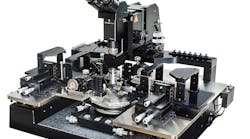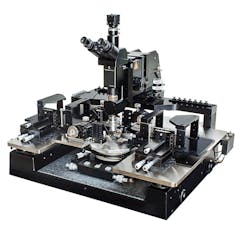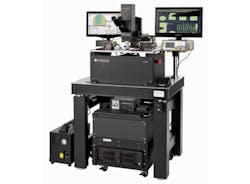This file type includes high resolution graphics and schematics when applicable.
The latest probe stations are providing solutions to achieve accurate measurements for higher-frequency applications. For instance, innovative designs enable probing to be achieved at terahertz frequencies. In addition, new probe-station control software delivers increased test-and-measurement efficiency. With the latest software improvements, gains in speed and productivity are achieved.
An example is Cascade Microtech’s recently released probe system, the EPS200MMW (Fig. 1). This pre-configured probing package handles manual 200 mm on-wafer measurements. The EPS200MMW is capable of providing measurements for advanced applications above 67 GHz, specifically targeting the 200 to 300 GHz frequency range and higher. Designed to provide functionality to achieve fast and accurate measurements, the EPS200MMW offers many key benefits.
To achieve accurate and repeatable measurement results, probe placement with submicron accuracy on calibration substrates and devices under test (DUTs) is critical. This need is even greater at frequencies from 200 to 300 GHz and higher. The EPS200MMW addresses this need with its solid-cast frame, along with a platen featuring four-point support. Those aspects enable the EPS200MMW to deliver superior stability, which allows high accuracy to be easily achieved. High-quality contacts are maintained throughout measurements by means of an integrated vibration-isolation solution.
In addition, the EPS200MMW provides a short signal path from instrument to device, enabling high dynamic range and directivity to be achieved without compromising electrical accuracy and mechanical stability. Its fine-glide chuck stage also provides coarse movement with wide-ranging capability as well as being able to provide fine movement in the submicron range. The EPS200MMW includes the WinCal XE on-wafer calibration software, which allows calibration accuracy to be achieved at terahertz frequencies. The EPS200MMW is also designed for upgradeability, enabling it to be easily reconfigured to meet future project requirements.
The EPS200MW provides manual probing measurements, but the company is also delivering advanced semi-automatic probing systems. The Summit Series probe station from Cascade Microtech is a 200-mm fully integrated semi-automated on-wafer terahertz probing system. Calibrated measurement results can be achieved at frequencies from 140 GHz to 1.1 THz. The probe station can be configured with programmable positioners to allow rapid and repeatable submicron positioning accuracy, ensuring high precision at the probe tip.
Interchangeable Modules
With its family of manual, semi-automatic, and fully automatic probing systems, SemiProbe also provides probing solutions to meet test requirements. The company’s Probe System for Life (PS4L) series of wafer probing systems is based on its patented adaptive architecture technology (Fig. 2). Unlike traditional systems, this technology allows all foundation modules, such as bases, stages, chucks, optics, manipulators, and more, to be interchangeable. As the environment or test conditions change, SemiProbe systems can be transformed on-site to meet these new demands, thus providing testing time and cost benefits.
The PS4L’s platen has a large surface, which accommodates multiple probe types, environmental chambers, and instrumentation. All SemiProbe semi-automatic and fully automatic systems operate on the PILOT control application suite, which is designed employing SemiProbe’s adaptive architecture. PILOT’s object-oriented software allows users to integrate the probe system quickly and easily with a broad array of test instrumentation. Drivers for most types of test instrumentation are readily available. In addition, new interfaces can easily be added.
Flexibility also is a goal for J microTechnology, which offers a line of probe stations for researchers, designers, and quality-control professionals. With an emphasis on supplying affordable probe stations in today’s market, these units are used for material research, semiconductor, solar, nanotechnology, and medical sensor applications.
For example, J microTechnology’s LMS-3009 probe station is intended for the research of advanced active and passive components. It also serves as an educational tool, training university students in the discipline of microwave microprobing.
Designed for RF/microwave applications, the LMS-3009’s features include a stereo zoom microscope and precision x-y-z positioning. Its benefits include its low cost, compact size, and easy setup. “With electronic components the size of coarse ground pepper, engineers and physicist need affordable test stations that give them optical and mechanical advantages,” said Jerry Schappacher of J microTechnology.
This file type includes high resolution graphics and schematics when applicable.
Software Advancements
This file type includes high resolution graphics and schematics when applicable.
With the emergence of the Internet of Things (IoT), it is estimated that 50 billion devices will be connected to the Internet by 2020. Huge amounts of data will move through the cloud, requiring semiconductor technology to convert data into serviceable information. Semiconductor manufacturers will be required to provide flexibility in test setups to accommodate a wide variety of designs. Demands will grow for increased correlation between instrumentation and equipment that can only be achieved through higher levels of integration.
Probe stations are satisfying these needs with strong software offerings. For example, Cascade Microtech recently released Velox 2.0, which is the latest version of the Velox probe-station control software. Velox 2.0 is designed to support the emerging demands of data processing, instrument integration, and processing flexibility. Collaboration on critical projects also is supported, allowing several users to work on a single recipe and share wafer maps across multiple stations.
Velox 2.0 consolidates the legacy Nucleus and ProberBench system software packages into a universal platform. It also is backwards-compatible with all current Cascade Microtech platforms. With emphasis on the automation of repeatable test and measurement processes, Velox 2.0 provides users with several options to simplify the setup and execution of automated sequences on their probe stations. Many automation features are now standard with Velox 2.0. AutoAlign, which is one of the automation features, measures die size and tracks wafer expansion. Cascade Microtech has committed to semi-annual upgrades of Velox, which provides users with increasing functionality as new capabilities are added.
For its part, SemiProbe has developed SPCal, which is a software application for vector network analyzer (VNA) calibration. SPCal provides step-by-step procedures to simplify and automate the calibration process, thereby reducing measurement time and eliminating errors. When integrated with the PILOT control software, SPCal delivers repeatable calibration with contact placement within 1 μm, maintaining a stable resistance between the substrate and the probe tip. The software supports most popular VNAs. Additional VNAs can be interfaced by using the SPCal ADD VNA feature. In addition, SPCal can perform S-parameter measurements and produce as many as four different plots with PILOT’s Plotter application.
The Configuration Challenge
The configuration of a device characterization system presents many obstacles. Equipment must be sourced from multiple suppliers. It then needs to be configured and proven on-site before a device can be tested. Measurement equipment, wafer probers, and other components—each having their own firmware or software control—must all be integrated to ensure data correlation and measurement accuracy. Weeks or even months can pass before the first measurements are executed.
In response to the need to achieve faster time to first measurement, Cascade Microtech and Keysight Technologies have partnered by closely synchronizing Velox 2.0 with Keysight’s WaferPro Express software. This wafer-level measurement solution for device characterization incorporates a semi-automated wafer probe station from Cascade Microtech along with a network analyzer or device parameter analyzer from Keysight. The WaferSync feature of Velox 2.0 is used when connecting a probe system to the WaferPro Express test executive. The interface and workflow are optimized for Cascade Microtech’s semi-automated probe stations, enabling quick setup and execution of automated wafer-level characterization measurements. IC-CAP, Keysight’s semiconductor device modeling software, has also been added to the WaferPro Express software bundle. Cascade Microtech’s wafer-level probe stations, microwave and DC bias probes, and calibration tools—combined with Keysight’s test instrumentation and measurement and analysis software—allow users to perform comprehensive measurements on all structures.
In summary, all of the latest probe stations offer a number of benefits, including the capability to perform accurate measurements at terahertz frequencies. Users also have the flexibility to configure systems to meet their specific requirements. In addition, software advancements provide the functionality to support the anticipated demands of the future.
This file type includes high resolution graphics and schematics when applicable.



